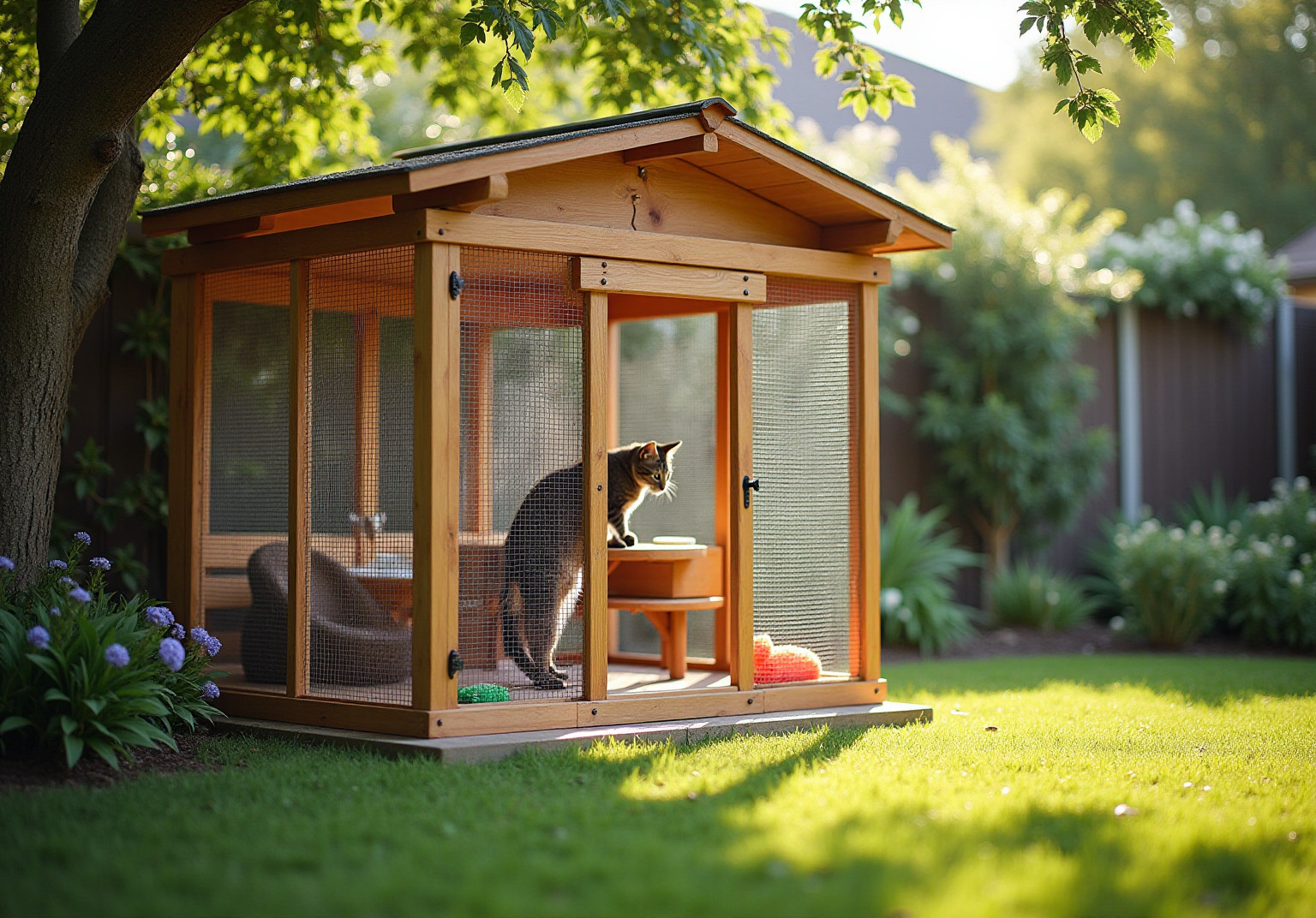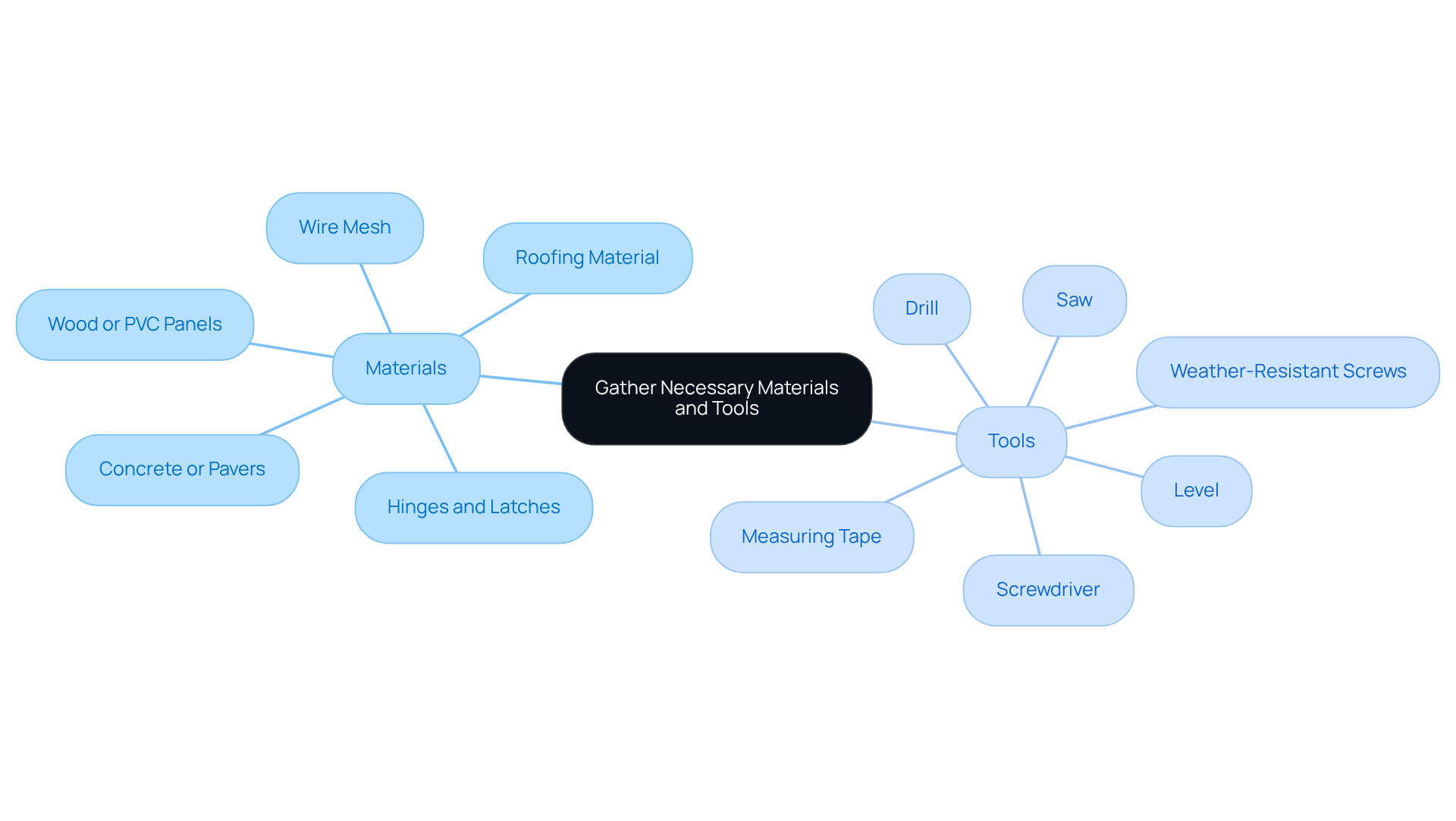
Build an Outdoor Cat Enclosure: A Step-by-Step Guide
Overview
This article serves as a heartfelt step-by-step guide for constructing an outdoor cat enclosure, highlighting its essential role in safeguarding the safety and happiness of our beloved feline companions. It thoughtfully outlines the necessary materials, construction steps, and troubleshooting tips, illustrating how a secure outdoor space not only shields cats from potential dangers but also enriches their lives by fostering increased mental stimulation and physical activity.
As pet owners, we understand the deep emotional connection you share with your cats, and this guide aims to empower you to create a nurturing environment that prioritizes their well-being.
Introduction
Creating a safe haven for your beloved feline can truly transform your peace of mind, enriching your cat’s life in ways you may not have imagined. Outdoor cat enclosures not only shield your precious pet from potential dangers, but they also offer an invaluable opportunity for mental and physical stimulation within a secure environment.
Yet, embarking on the journey to construct one can present challenges that might leave you feeling uncertain about your approach. What essential steps and materials are necessary to ensure a successful build? How can you effectively address common issues that may arise along the way?
These questions reflect the genuine concern you have for your furry friend, and together, we can explore the nurturing solutions available to you.
Understand the Importance of an Outdoor Cat Enclosure
Creating an outdoor cat enclosure in the open air can be a wonderful way to ensure your feline friend enjoys the beauty of nature while staying safe from the potential dangers of unrestricted wandering. As a loving pet owner, you want what’s best for your cat, and outdoor enclosures offer several compelling reasons to consider this option:
-
Safety is paramount; these enclosures shield your cat from threats like predators and traffic, providing a secure space for exploration. Imagine the peace of mind knowing your beloved pet is safe while they enjoy the fresh air.
-
Moreover, outdoor access significantly enriches your cat’s life. It enhances mental stimulation and physical exercise, both of which are essential for reducing boredom and preventing behavioral issues. Cats thrive on sensory experiences, and an external habitat serves as a natural playground for climbing, exploring, and interacting with their surroundings, allowing them to express their instincts in a safe environment.
-
The health benefits are equally important. Regular exposure to fresh air and sunlight can elevate your cat’s mood and overall well-being. Research indicates that access to nature can lead to improved physical health, such as better weight control and a lower risk of diabetes, as cats engage in more active behaviors outdoors.
-
Lastly, knowing your cat is safe in an outdoor cat enclosure while enjoying the outdoors helps alleviate the anxiety often felt by pet owners. The setup of external barriers has been shown to enhance the quality of life for both felines and their caretakers, with many owners reporting a significant reduction in stress-related behaviors.
By understanding these benefits, you can truly appreciate the value of creating a secure area for your cat, ultimately contributing to their happiness and well-being. Together, let’s ensure our furry companions lead fulfilling and joyful lives.

Gather Necessary Materials and Tools
Before you embark on your outdoor cat enclosure project, it’s essential to gather the right materials and tools to ensure a successful construction that prioritizes your beloved feline’s safety and comfort.
Materials:
- Wood or PVC Panels: Opt for 2×4 lumber for most framing to guarantee stability and durability in the structure, providing a secure haven for your cat.
- Wire Mesh: This vital component creates a protective barrier; using 16-gauge wire with a 2″ x 3″ grid opening allows visibility and airflow while keeping your cat safe from potential predators.
- Roofing Material: Choices like corrugated plastic or shingles will shield your structure from rain and sun, fostering a cozy atmosphere for your furry friend.
- Hinges and Latches: Heavy-duty hardware is crucial for doors, ensuring secure access and preventing any escapes, giving you peace of mind.
- Concrete or Pavers: These materials provide a stable foundation, enhancing the overall durability of the structure, which is so important for your pet’s safety.
Tools:
- Saw: An essential tool for cutting wood or PVC panels to the necessary sizes, allowing for a precise fit.
- Drill: This tool is used to create holes for screws and hinges, making assembly easier and more efficient.
- Screwdriver: Necessary for securing the structure together, ensuring it stands strong and safe.
- Measuring Tape: This ensures that every dimension is precise, creating a well-fitted space for your cat to enjoy.
- Level: Important for confirming that the structure is even, which is vital for its stability and your peace of mind.
- Weather-Resistant Screws: Using galvanized or stainless steel screws prevents rust, ensuring the longevity and safety of the structure for years to come.
The total expense to construct this safe haven is roughly $300. By having these materials and tools prepared, you will simplify the construction process of your outdoor cat enclosure, allowing you to focus on creating a safe and pleasant area for your feline companion, reflecting your love and care for them.

Follow Step-by-Step Instructions for Construction
Creating a safe and enjoyable outdoor cat enclosure for your beloved cat is an important endeavor, and it can be achieved with a few thoughtful steps. Let’s explore how you can construct an outdoor cat enclosure that not only protects your furry friend but also enriches their life.
-
Choose the Right Location: Begin by selecting a flat area in your yard that offers a comforting blend of sunlight and shade. It’s essential to ensure this space is free from potential hazards such as sharp objects or nearby roads, as your cat’s safety is paramount.
-
Measure and Mark: With a measuring tape in hand, outline the dimensions of your desired enclosure on the ground. This step is crucial to ensure that the area meets your cat’s needs for movement and comfort, allowing them to explore their surroundings freely.
-
Build the Frame: Carefully cut your weather-treated wood or PVC panels to the specified sizes. Assemble the frame using screws and a drill, ensuring that the structure is robust and securely fastened to withstand outdoor conditions. Opt for rust-resistant screws to enhance durability, giving you peace of mind.
-
Attach the Wire Mesh: Next, cut the wire mesh to fit the frame perfectly, securing it with staples or screws. It’s vital to check for any gaps that could allow your cat to escape or predators to enter. A maximum mesh size of 50 × 50 mm is recommended to ensure security.
-
Install the Roof: Affix roofing material to the top of the structure to shield your cat from rain and sun. Make sure it is securely attached to prevent leaks, and consider using polycarbonate sheeting to allow natural light while providing shelter.
-
Create Access Points: Installing doors with hinges and latches is essential. Ensure they open and close smoothly, providing secure access for your cat. Self-closing hinges can further enhance security, giving you confidence in their safety.
-
Incorporate Enrichment Features: To make the enclosure a stimulating environment, add shelves, scratching posts, climbing structures, and rotating toys. These features promote physical activity and mental stimulation, creating a joyful space for your cat. Including small water fountains or bird feeders can also provide delightful viewing experiences.
-
Conduct a Final Inspection: Finally, take a moment to carefully check for any sharp edges or gaps. Ensure that the structure is securely fastened and stable. Make any necessary adjustments to guarantee a safe and comfortable environment for your cat, including securing it to the ground with stakes or similar solutions.
By following these thoughtful steps, you will create a secure and enjoyable area that allows your cat to safely experience the great outdoors, enriching their life and giving you peace of mind.

Troubleshoot Common Issues During Construction
As you embark on the journey of constructing your outdoor cat enclosure, it’s natural to encounter several common challenges. Acknowledging these hurdles is the first step toward creating a safe haven for your beloved feline companion. Here are some thoughtful solutions to help you navigate these issues with care:
- Misaligned Panels: If you notice that your panels are misaligned, take a moment to revisit your measurements and make the necessary adjustments. Starting with precise measurements is key to preventing this issue. As Cynthia Chomos, founder of Catio Spaces, kindly reminds us, constructing on a flat, level surface is essential for avoiding misalignment and ensuring stability for your furry friend.
- Weak Structure: If the frame feels a bit unstable, consider reinforcing it by adding extra supports or brackets. This simple step can significantly enhance the overall stability and safety of the enclosure. It’s particularly important to remember that many cat owners—about 30%—express genuine concern about managing bills and living costs. Thus, investing in a sturdy structure is vital for long-term peace of mind.
- Gaps in the Mesh: To address any gaps in the wire mesh, ensure it is tightly secured. Using additional staples or screws as needed will help maintain a secure fit and prevent any potential escapes. Remember, utilizing strong, pet-safe mesh is critical to safeguarding your cat from wildlife threats that may lurk nearby.
- Difficult Door Operation: If you find that the door is sticking, take a moment to inspect the hinges for proper alignment. Often, adjusting the hinges can resolve this issue, allowing for smooth operation and easy access for your curious cat.
- Weather Resistance: If you notice any leaks in the roof, check that the roofing material is securely fastened. Applying a waterproof sealant can provide extra protection against leaks, ensuring your cat stays dry and comfortable. A well-constructed roof is essential not only for protecting your cat from predators but also from adverse weather conditions.
By addressing these issues promptly and with care, you can facilitate a successful construction process, ultimately creating a safe and enjoyable outdoor cat enclosure for your cherished cat.

Conclusion
Creating an outdoor cat enclosure is a heartfelt way to enrich the lives of our feline companions while ensuring their safety. By offering a secure space for exploration, these enclosures allow cats to bask in the joys of the outdoors without the dangers that come with free roaming. The peace of mind that arises from knowing your cat is safe and content in a protected environment is truly invaluable.
This guide has illuminated the many benefits of outdoor cat enclosures, such as:
- Enhanced safety from predators and traffic
- Increased mental and physical stimulation
- Improved overall health
It has also outlined the essential materials and tools needed for construction, providing step-by-step instructions to ease the building process. Common challenges, along with practical solutions, were addressed to ensure a smooth construction experience, reflecting our shared commitment to our pets’ well-being.
Ultimately, building an outdoor cat enclosure not only enriches a cat’s life but also nurtures a deeper bond between pet and owner. Embracing this project is an investment in a cat’s happiness and well-being. Taking the time to create a safe outdoor space will lead to countless joyful moments for both cats and their caretakers, fostering a fulfilling life filled with adventure and exploration.
